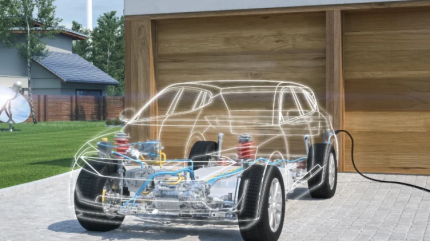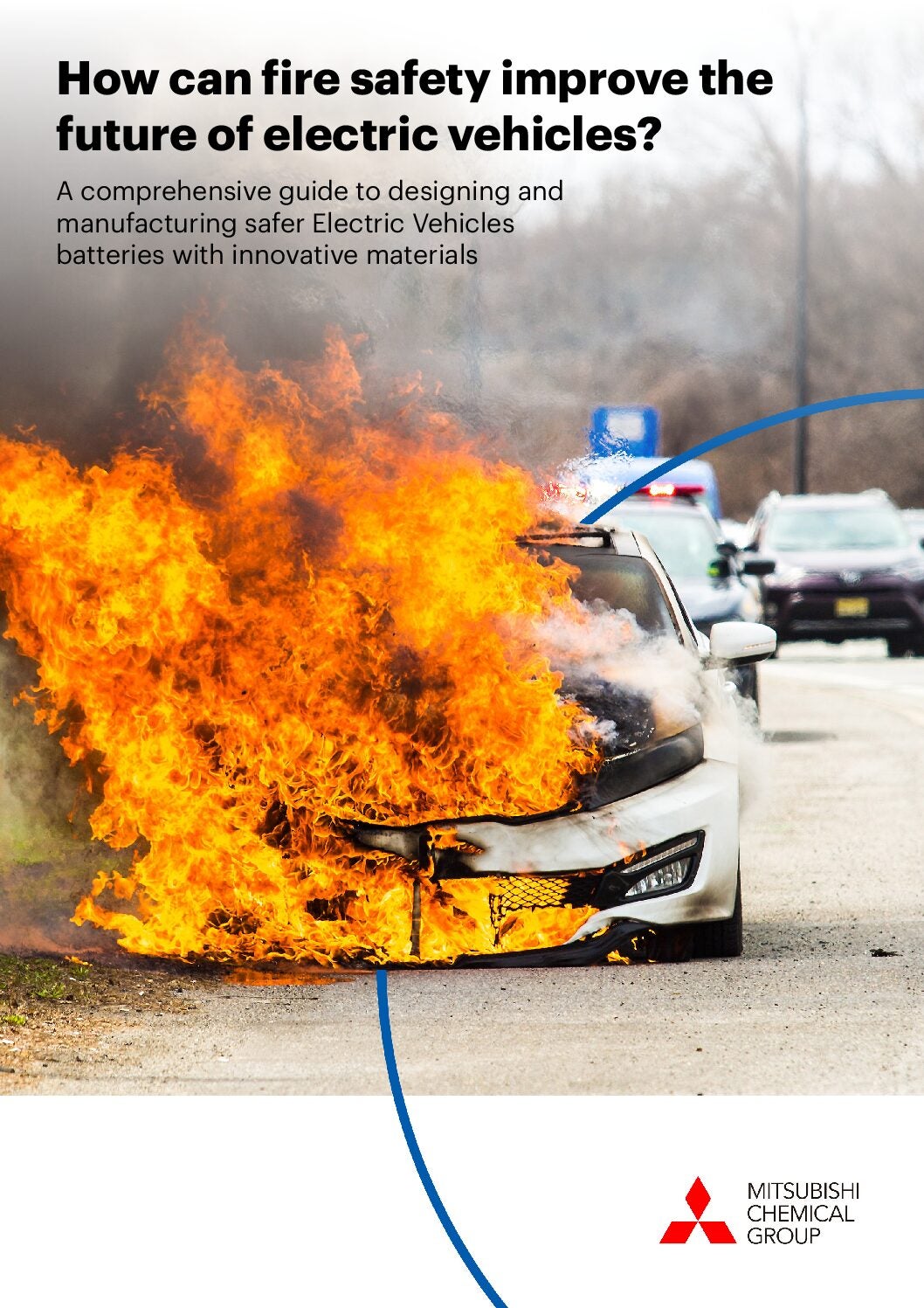
Electric vehicle (EV) battery thermal runaway represents a significant safety concern within the automotive industry, linked to the use of lithium-ion batteries. The phenomenon occurs when a battery cell reaches a critical temperature, triggering a self-heating reaction that can lead to catastrophic failures, including fires and explosions. The risks associated with thermal runaway have garnered heightened attention as electrification accelerates, necessitating robust safety measures and innovative materials to mitigate them.
Essential in EVs for managing battery temperature, advanced cooling tubes enhance performance and reduce fire risks. Integrated into modern thermal management systems, cooling tubes made with the latest new materials are now entering manufacturing pipelines to protect battery cells.

Does the rapid rise of EVs increase fire risk?
According to research by analytics firm GlobalData, annual global EV sales will surpass 50 million units by 2028. Between 2023 and 2028 the global EV market will see a compound annual growth rate (CAGR) of 16.1% – reaching 53.9 million units. Battery electric vehicle (BEV) production will overtake that of hybrids (HEVs) to become the leading electrified driving option on the market by the end of this period[i].

Global battery production for battery electric vehicles will exceed 1 TWh in 2024 with China remaining the top global supplier of BEV battery cells through the decade. However, GlobalData predicts that, by 2029, it will account for less than half of global production, with Europe and North America outpacing China in the next decade.

Concerns around the risk of battery fires will only rise as the number of EVs on the road grows and vehicles age. Further, as demand for smaller, more powerful batteries increases, the risk of short-circuiting and overheating in EVs increases – potentially leading to dangerous fires and explosions. Despite this, data shows that EVs powered by lithium-ion batteries are no more likely to catch fire than internal combustion engine (ICE) vehicles.
Research from the Swedish Civil Contingencies agency shows that, in 2022, there were 23 fires from 611,000 EVs in Sweden, translating to a fire incidence of 0.004%. In contrast, 3,400 fires occurred in 4.4 million ICE vehicles, representing a fire incidence of 0.08%. And according to a recent BBC investigation, England saw 59 electric vehicle fires referenced in 2022-23, up from 30 the previous year. This compares with fire services across England recording more than 19,000 vehicle fires in total within the same period.
However, EV fires can be more aggressive and dramatic when they do occur, primarily due to the nature of lithium-ion batteries. These batteries may become volatile if damaged, especially in a crash scenario, making them difficult to extinguish. First responders require specific firefighting techniques and knowledge, often requiring immersion in water for extended periods to ensure batteries are fully inert.
The perception that EVs pose a greater fire risk than combustion vehicles is largely influenced by high-profile incidents and media coverage. However, for passenger safety, all risk of fire must be carefully accounted for, with sophisticated battery management systems (BMS) the driving force behind EV fire prevention.
Importance of temperature management
As well as mitigating fire-risk, temperature management is crucial for the optimisation of the batteries. The optimal operating temperature for lithium-ion batteries commonly used in EVs, is between 20-40°C. Maintaining this temperature range is essential for preserving battery health, ensuring peak performance and extending the lifespan of the battery pack. Excessive heat can accelerate battery degradation, leading to reduced range and efficiency over time.
Modern cooling systems use both heating and cooling circuits to maintain battery temperature across various environmental conditions and is designed to be flexible, allowing integration into diverse vehicle layouts while ensuring optimal temperature control. Advanced cooling tubes facilitate the circulation of coolant around the battery cells, promoting consistent temperature distribution and maximising energy output.
An intelligent BMS setup is vital for the long-term health of an EV, as lithium-ion batteries gradually degrade over time – with excess heat accelerating this process. Understandably, automakers are investing time and money into improving their BMS units to maximise performance and range as well as mitigating any fire risk from overheating.
The technology behind EV battery cooling tubes
Advanced cooling tubes in EVs are a critical component of the thermal management system – mitigating fire risk and enhancing vehicle performance by effectively regulating battery temperature. Mitsubishi Chemical Group (MCG) is addressing these challenges by developing new battery materials and processes.
Steffen Kammerer, Regional Segment Manager, Energy Storage Systems, at Mitsubishi Chemical Europe, emphasises the importance of coolant tubes in fire safety for batteries.
“There are three cooling categories, air, liquid, and refrigerant, with liquid cooling being the most relevant for battery cars,” explains Kammerer. Enabling coolant tube designs system that efficiently house cooling fluids, he argues, can significantly increase safety battery profile and the durability.
The use of cutting-edge materials like polyamides (PA) can play a key role in multi-layer systems for battery cooling lines. Polyamides are often combined with polyolefins to create multilayer systems that improve cost-performance balance, durability, heat and creep resistance. They provide excellent durability for glycol-water mixtures (cooling the battery system) and heat resistance up to 110°C.
“Offering unmatched adhesion, thermoformability and heat resistance, MODIC™ and ADTEX™ tie layer resins for Multilayer coextruded cooling tubes for example, can improve thermal management – particularly when combined with thermal responsive spacers to harness heat flows. By mitigating the chances of fire breaking out and preventing its spread when it does, risks to passengers can be dramatically reduced,” says Kammerer.
Additionally, enabling mono-material tubes offer advantages in cooling systems like flexibility, such as ease of bending and short radius, while low creep materials are crucial for maintaining connection over time. MCG’s approach also emphasises sustainability, easy recycling and dimensional stability. Innovations like flexible TEFABLOC™ TPEs and composite materials contribute to enhance fire safety and performance without compromising vehicle efficiency. Soft TPE are sometimes combined with textile reinforcement used for improving burst pressure resistance (if required). These innovations have improved fire safety while also optimising performance.
Mitsubishi Chemical Group offer:
- MODIC™ or ADTEX™ adhesive polymers – combined with Polyolefin (PE, PP) type polymers and polyamide (PA) correspondingly to create a multi-layer solution with excellent layer adhesion.
- TEFABLOC™ Thermoplastic Elastomers: Ideal for mono-layer systems, flexible battery cooling lines to house the liquid Glycol/H20 mixture as it cools the battery system. These offer easy processability, forming & dimensional stability, as well as being sustainable solutions and easily recycled.
According to Kammerer, immersion cooling can significantly extend the battery pack lifetime of EV-mobility powertrains by keeping the temperature of battery cells under much tighter control, which is an unmet need and a key trend to watch out for. However, cost and weight concerns have not expanded this technology besides niche applications to become mainstream.
“With further evolution, we believe it could become the mainstream in the next decade,” he says. “If so, then I think material designs will also change, because they have different requirements. There is a different additional element that requires conductive layers as dielectric fluids flow through there and can generate sparks. So, it is essential to remove the electric loads from the tube.
Risk-reducing innovations
Mitsubishi Chemical Group is a leading material, battery system, and testing process pioneer in electric vehicles. Their portfolio of innovative materials and technologies is at the forefront of EV fire safety innovation. MODIC™, ADTEX™ and TEFABLOC materials play a key role in battery cooling lines and tubing applications, offering unmatched performance, mitigating fire breakout risks to passengers by preventing its spread.
MCG has also developed flame-retardant polymer compounds to prevent fires in EV components. Their Hostaphan™ PET film manages heat expansion between EV battery cells, while their Sol-Rite™ electrolytes improve battery performance under high voltage and temperature conditions. Anode materials like modified graphite offer power performance and longevity, and are specifically designed to reduce reaction resistance, thereby minimising ignition risks.
Guided by its KAITEKI vision to “achieve the sustainable wellbeing of people and the planet”, Mitsubishi Chemical Group is the manufacturers’ premium partner in the EV revolution, addressing critical fire safety concerns while enhancing overall vehicle performance. Their record of innovation creates a path towards a future for electric vehicles that combines safety and efficiency.
For further information, download the free report below.
[i] GlobalData: Thematic Intelligence Automotive, Automotive Predictions 2024, January 2024



